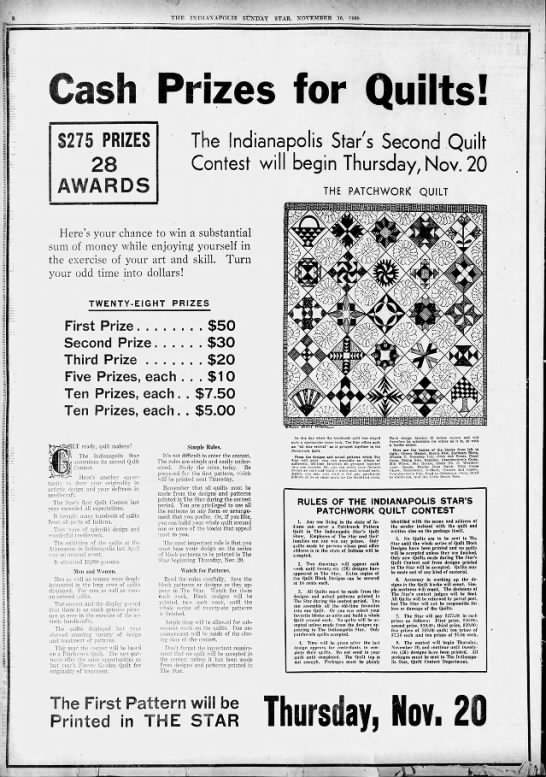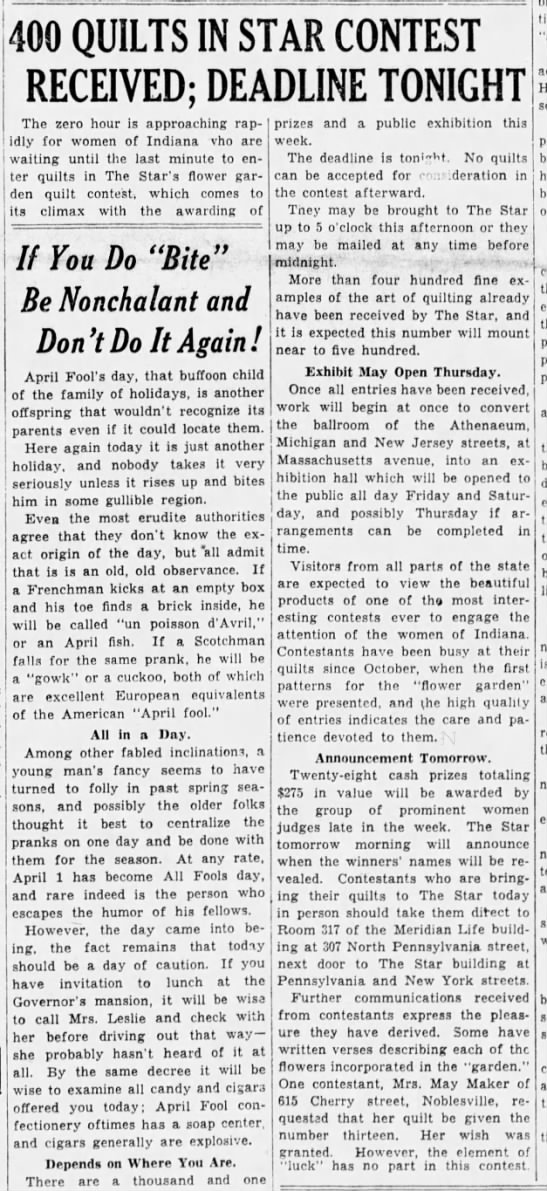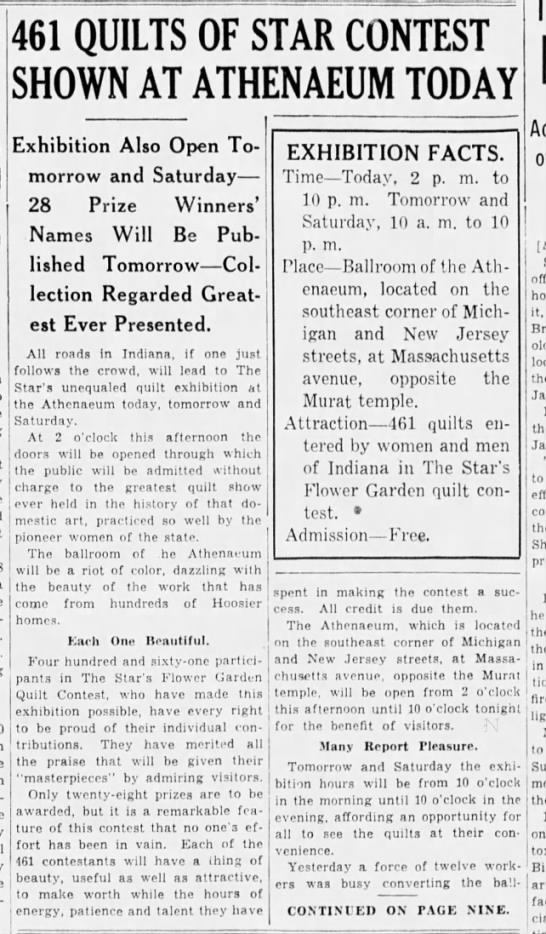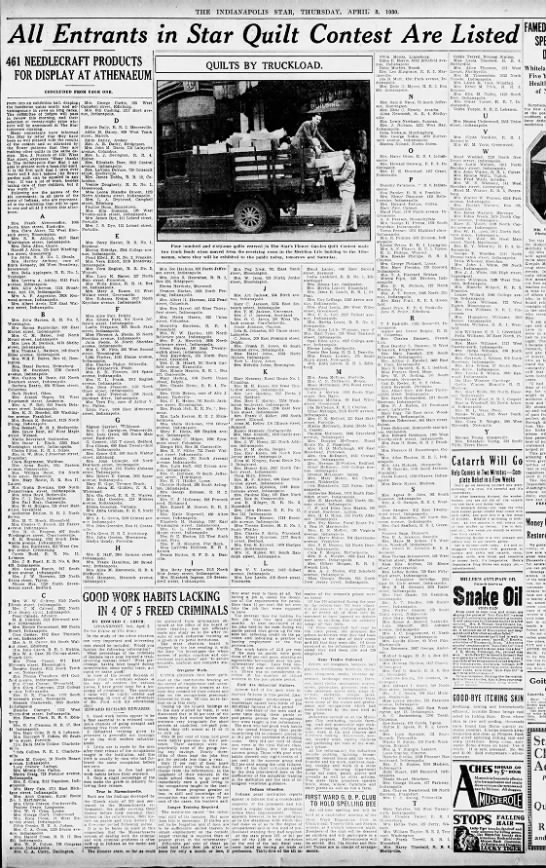Vintage newspaper quilt block patterns took me researching a quilt contest and a family mystery.
The Quilt Block Patterns
A member of my weekly quilt group is moving and downsizing. Among the things Karen brought to the free table was a package of envelopes with quilt block templates. My savvy lady friends quickly set it aside for me!
The patterns had belonged to Karen's friend Delphine (Del) Theman.
The patterns were shared in the Indianapolis Star in 1939 as part of their second Quilt Contest. I quickly recognized the patterns as by Ruby McKim.
 |
| November 16 ad for the Quilt Contest in the Indianapolis Star |
The contest had a total of $275 in prizes! First prize won $50, second, $30, third prize, $20. There were five $10 prizes, ten $7.50 prizes, and ten $5 prizes. Ladies sent their completed quilts to the Quilt Contest Department at the Indianapolis Star.
 |
| Envelope holding quilt block pattern |
Each envelope had the quilt block on the front and was noted by name and by number.
Inside each envelope were the original article and the original pattern, cut apart. I found the pattern in Newspapers.com, seen below.
 |
| the November 20, 1930, article in the Indianapolis Star |
She made another pattern which included seam allowances for cutting.
You can see in the photo above the pattern piece cut from the newspaper article and the hnd made pattern piece made with seam allowance added.
Also with the group was an illustration of the blocks in a quilt pattern layout with quilting motifs noted. The illustration was later hand penciled to enhance the illustration.
The block patterns included:
- Cherry Basket
- Bear's Paw
- Sunbeam
- Double T
- Crazy Ann
- Noon Day Lily
- Old Corn & Bean
- The Rising Sun
- Grandmother's Cross
- Rambler
- Mill Wheel
- The Skyrocket
- The Weather Vane
- Spool or Jenny Lind
- Double Nine Patch
- Wild Goose Chase
- The Strawberry
- V-Block
- Crosses & Losses
- Grandmother's Fan
- Road to Oklahoma
- Hickory Leaf
- Road to California
- The Palm Leaf
- Little Beech Tree
Here you can see the backside of the newspaper patterns.
And the paper patterns including seam allowance that she made for cutting the fabric.
Over 400 quilts were entered into the contest!
 |
| April 1, 1930, Indianapolis Star article |
 |
April 3, 1930, Indianapolis Star article
 |
The Mystery
I researched Del on Ancestry.com. It quickly became obvious that in 1930 Del was only ten years old and she was not the collector and preserver of these patterns! Did her mother make the quilt? Did she inherit or obtain the patterns from someone outside of her immediate family?
I researched Del's family tree to see if I could garner any clues.
Del was born in Penzance, Cornwall, England on January 1, 1920, and died April 20, 2008, in Michigan. When Del was four years old she immigrated on the Melita, arriving in Quebec with her mother Emily Rosina James (age 24) and sisters Emily, Eileen Pearl, and Rosina Ellen. Emily Rosina James had been living with her mother Charlotte Standbridge.
Del's father was William Henry James and I found his Petition for Citizenship dated March 21, 1923. The document also noted that his wife Emily arrived in America on April 4, 1925. This proved that William had immigrated before his family and sent money back for their passage. This was how my Grandparents on both sides of my family came to America, the husband crossing first, obtaining work and housing, and then sending for his family.
I learned more about Del's parents.
William was born July 5, 1894, in Cornwall, England. He married Emily on October 26, 1918. Emily was born in Southampton, England on April 5, 1900. At the time of William's petition, his children were listed as Delphine, Eileen (born March 19, 1921), Rosina (born July 25, 1935), who were both noted as being born in England, and Kathleen (born December 12, 1928) born in Detroit, MI.
 |
| William Henry James's naturalization petition |
William's naturalization record of March 15, 1930, showed William was 5'5" with brown hair and fair skin and weighed 115 pounds. He immigrated to Windsor, Canada, arriving on March 18, 1923, his wife and children still in England.
The 1930 Census shows the family living on Wabash Avenue in Detroit, MI. William was a 'tool man' working for Ford Motor. He became an American citizen in 1922 and Emily was naturalized in 1924. The family appears in the 1940 census as well.
On August 25, 1945, Del married Earl Henry Theman. Earl was 37 years old. His father's name was Ernest Theman. Earl's draft card dated October 16, 1940, showed he was living with his mother Anna Hessell Theman. Earl had a ruddy complexion with brown eyes and hair and was 5'8" tall. He worked for Ford Motor. Earl died on March 31, 1993.
Here was a mystery. The marriage certificate shows the bride's name as Delphine Irene Pegouske!
Karen always remembered Del talking about 'my Johnny." This was clearly not Earl's name.
I did a search for Delphine Irene Pegouske and found a marriage on November 20, 1941, to John Elroy Pegouske, son of William and Lucy Bourrassa Pegouske, 21 years old and living in Dearborn, MI. Witnesses at the wedding were John's brother Everett Pegouske and his wife Emma Leora Phieffer Pegouske.
So, Del was married before and her husband's relatives witnessed her second marriage! It was time to look into Johnny.
John was born June 22, 1916, in Melvindale, Wayne County, Michigan.
"My Johnny" enlisted on October 16, 1940. He was 24 years old, 5'9" tall with blonde hair, gray eyes, and a light complexion, born on June 21, 1916. He worked for the Thornton Tandem Co. He was an army technician 4th grade and his religion listed as Catholic.
According to his niece who posted on Ancestry.com, Johnny died on July 15, 1944, when his truck ran over a hidden land mine in Italy. John was buried in Sicily-Rome American Cemetery and Memorial in Nettuno, Città Metropolitana di Roma Capitale, Lazio, Italy.
No wonder that John's family witnessed Delphine's marriage to Earle Theman. They were supporting her to move on from her devastating loss.
Now I was curious about the Pegouske name. It is similar to my married name. There are many spellings of the name in my husband's family tree.
My husband's grandfather's name was transliterated as Bekofske and his brother's name was transliterated as Pekoske. Gary's father called his family Prussian. My research showed they were Germans who moved into Poland and then into the area now called Ukraine before immigrated to America. Also, the 'e' ending is more usual for Prussian names.
A family tree on Ancetry.com shows the Pegouske line going to Frantz (later Frank) Pajatzky (1835-1918) in Germany/Prussia, arriving in America on June 6, 1870. Frantz married Augusta Justine Mandilke (1839-1921).
Franz and Augusta's son William (1876-1946) married Lucy Philomene Bourassa (1881-1929) and they had 15 children including John Elroy who predeceased his father by two years. William was a widower when he died in Eloise, Wayne, Michigan.
William's death in
Eloise, Wayne, Michigan rang a bell for me. A few years ago our library book club read
Annie's Ghosts by Steve Luxenberg about an unknown relative cloistered away in the Eloise Hospital. What was established as the Eloise Poorhouse became the Eloise Sanitarium or Hospital, at its peak a huge complex, a city in itself. In 1945 it was named the Wayne County General Hospital and Infirmary. People were sent there for many reasons. I don't know if William was ill or had dementia or had no where else to live.
The family name was also transcribed as Pogoska, Pelgotssky, Pagutski, Pegonsky, and finally Pegouske.
My friend Karen never talked to Del about her family history. We still don't know who collected the Sampler Block articles. But I had fun researching all these mysteries!
The first Quilt Contest held by the Indianapolis Star was for Ruby McKim's Flower Garden quilt.
See vintage Ruby McKim sampler quilts at
Quilts-Antique and Vintage
https://quilts-vintageandantique.blogspot.com/2010/01/ruby-mckim-1930-patchwork-quilt.html
Material Things by Barbara Brackman
https://barbarabrackman.blogspot.com/2013/02/ruby-mckim-in-denver-post.html





















































